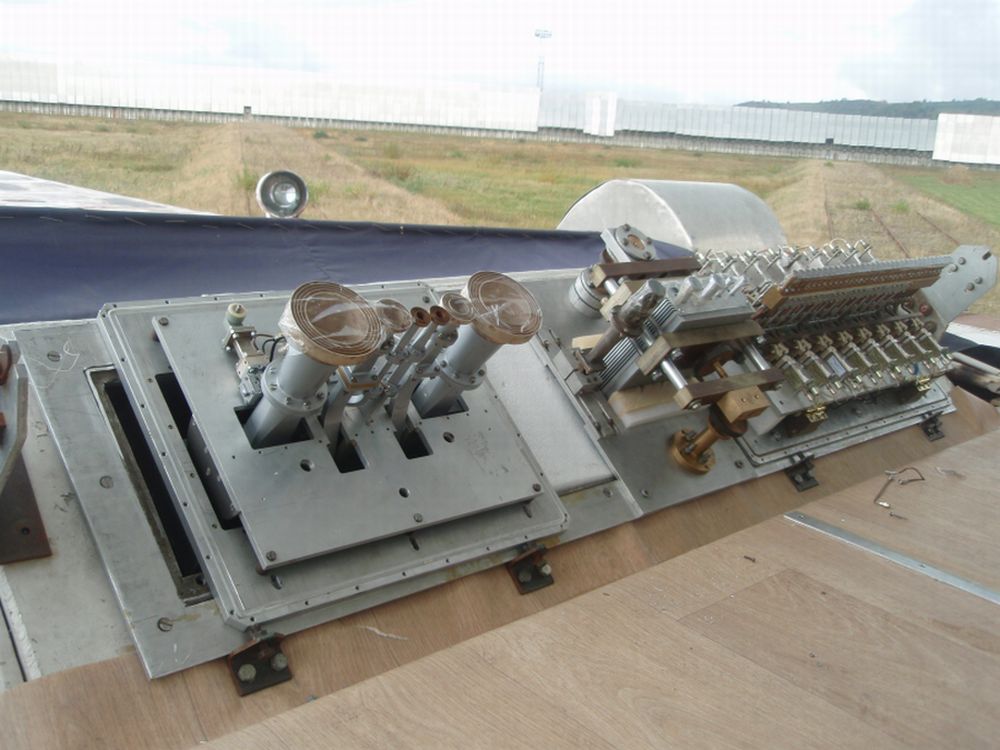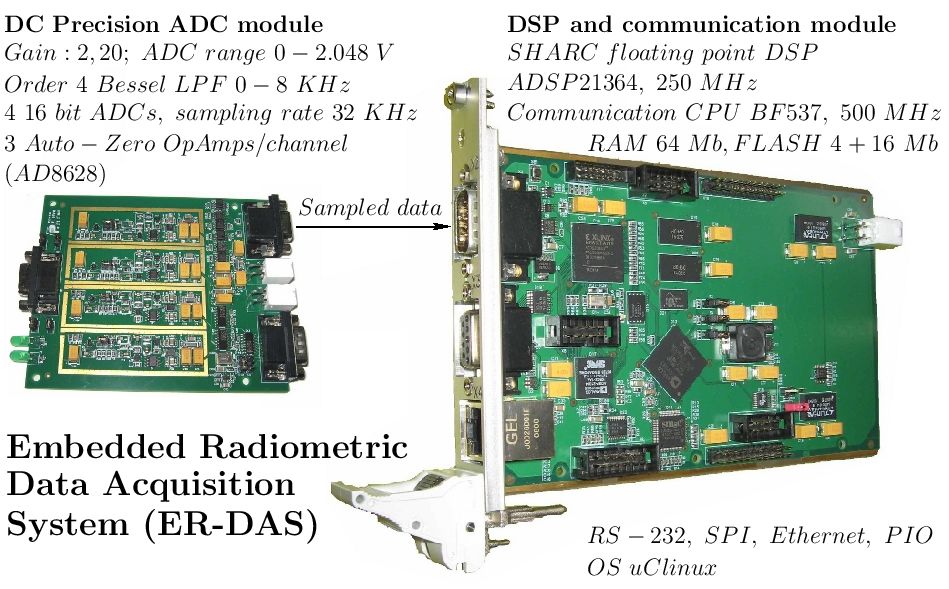
Fig. 1. Feed cabin Nr. 2
"Eridanus-2"
The reconstruction of the RATAN-600 three-frequency cryogenic receiver
"Eridanus" is finished. Three independent radiometers at wavelength
1.0, 2.7 and 6.3 cm were placed in a joint cryostat with liquid nitrogen.
The FET amplifiers at all three wavelengths as front-end stages were used.
This allows to realize the sensitivity at frequency ranges 4.8, 11.2 and 30.0
GHz of 5, 7 and 12 mK by double beam switching mode and by the integration
time of the output filter 1s.
Input waveguide paths were very long and had big losses.
When designing the shortest wavelength 1.0 cm of three-frequency radiometric
system "Eridanus" on the RATAN-600 secondary mirror N2 was less popular due
to the installation here multi-channel system "Mars-3", which has the same
central frequency, but has developed on modern element base.
Therefore, it was reasonable to upgrade to a close and a often used wavelength
of 1.4 cm in demand, despite a significant increase as the amount of effort
to develop, manufacture and installation of elements of the front-end and
output units, and the additional financial costs on the order of the low
noise amplifiers and other microwave components.

Fig. 2. The focal line of the feed cabin Nr. 2.
From left to right: three-frequency system "Eridanus-2", adjustment set
equipment and 16-channel radiometric system "Mars-3".
It was decided to abandon the bulky nitrogen cryostat and redesigned front-end
part under uncooled version. This made it possible to optimize the input path
of short-wave radiometers, go to the fully symmetric geometry waveguide paths
with the location in the center of the primary feeds range 1.4 cm, 2.7 cm,
and then, finally, 6.3 cm.
Given the successful experience of implementation of the "quasi-total power"
mode on a matrix radiometric system "Mars-3" for use in single-beam receiving
mode, such a scheme is implemented in the "Eridanus-2" system, since the
"noise added radiometer" (NAR) mode is difficult to realize and ineffective
at short centimeter wavelengths due to atmospheric variations.
For successful implementation of the project was carried out search and order
of LNAs on the latest PHEMT-transistors on all three waves, noise-optimized
under uncooled option. Parameters of products were analyzed of several
developers were analyzed.As a result, it was decided to purchase and use
of already manufactured in series amplifiers SPC "Micran", Tomsk, with some
modifications according to our specification.
The operating parameters of three-frequency system "Eridanus-2" are given
in table 1.
Table 1
| Additive noise temperature at wavelengths, K |
1.4 cm |
2.7 cm |
6.3 cm |
| Antenna at middle elevations |
30 |
25 |
23 |
| Front-end waveguides |
21 |
15 |
10 |
| Waveguide switch (in beam switching mode only) |
21 |
15 |
10 |
| Ferrite isolator |
21 |
21 |
- |
| LNA of SPC "Micran" |
92 |
24 |
17 |
| System noise temperature |
185 |
100 |
60 |
| The frequency bandwidth, GHz |
2.5 |
1.0 |
0.8 |
| The calculated sensitivity by 1s, mK |
5.5 |
5.0 |
3.5 |
| Former nitrogen option, mK |
10-12 |
7.0 |
5.0 |
"MARS-3"
Matrix radiometric system MARS-3 was developed for technical support of the
program to locate of the cosmic microwave background fluctuations
"Cosmological Gene of the Universe" (Head Academician Yu.N. Parijskij).
It represents 16 independent radiometers, 32 primary feeds are located along
the focal line of the secondary mirror with an interval of 20 mm.
The main part of each radiometer is a miniature radiometric module, designed
on the basis of MMIC technology using the latest achievements of the
electronics industry. Block diagram of the module includes an input LNA
(f. Fujitsu), back-end amplifiers, band-pass filter, a microwave detector
and preamplifier.
The operating parameters of the module:
The center frequency - 30.0 GHz, bandwidth - 5.0 GHz, equivalent noise
temperatures - 170-185 K. This allows with total equivalent noise temperature
of about 220 K to implement sensitivity in the modulation mode for each
radiometer 5 mK reduced to 1 second time constant of the output filter.
Data Acquisition and Control System
The Data acquisition system of the feed cabin Nr 2 is based on the new
measurement ER-DAS system (Embedded Radiometric Data Acquisition System).
It is a "building block" for the development of distributed systems,
multi-channel signal acquisition.
Details The measuring system is described in the section References.

Fig. 4.
The measurement system ER-DAS has 4 channels. Currently possible to measure
signals from 19 radiometers, it requires a 5-Measuring Systems ER-DAS, see
the block diagram of DAS of feed cabin Nr. 2 in Fig. 5.
The digitized signals of radiometers are marked by the exact time (better
than 1 millisecond accuracy). Local Time Service is based on the GPS receiver
and the local NTP (Networked Time Protocol) time service.
Data logging is done automatically, according to a prepared observation
program.
The results of each observation are automatically moved to the
archiving center to accommodate in a database and further processed.

Fig. 5. The block diagram of DAS of feed cabin Nr. 2.
References
-
А.Б. Берлин, Ю.Н. Парийский, Н.А. Нижельский, М.Г. Мингалиев, П.Г. Цыбулев,
Д.В. Кратов, Р.Ю. Удовицкий, В.В. Смирнов, А.М. Пилипенко
"Матричная радиометрическая система МАРС-3 для РАТАН-600",
Астрофизический Бюллетень, 67(3), 2012, с.354-366.
-
А.Б. Берлин, Н.А. Нижельский, П.Г. Цыбулев, Д.В. Кратов, Р.Ю. Удовицкий,
Б.И. Карабашев "Реконструкция трехчастотного криорадиометра "Эридан",
Труды Института Прикладной астрономии РАН, 2012, вып.24, стр. 183-186.
-
P. Tsybulev
"New-Generation Data Acquisition and Control System for Continuum
Radio-Astronomic Observations with RATAN-600 Radio Telescope:
Development, Observations, and Measurements",
Astrophysical Bulletin, vol. 66, p.109 (2011).
|


